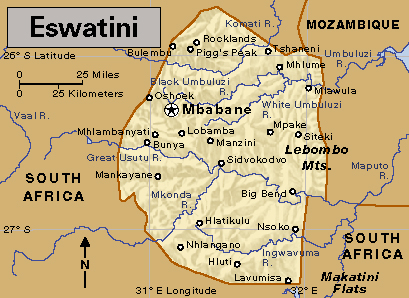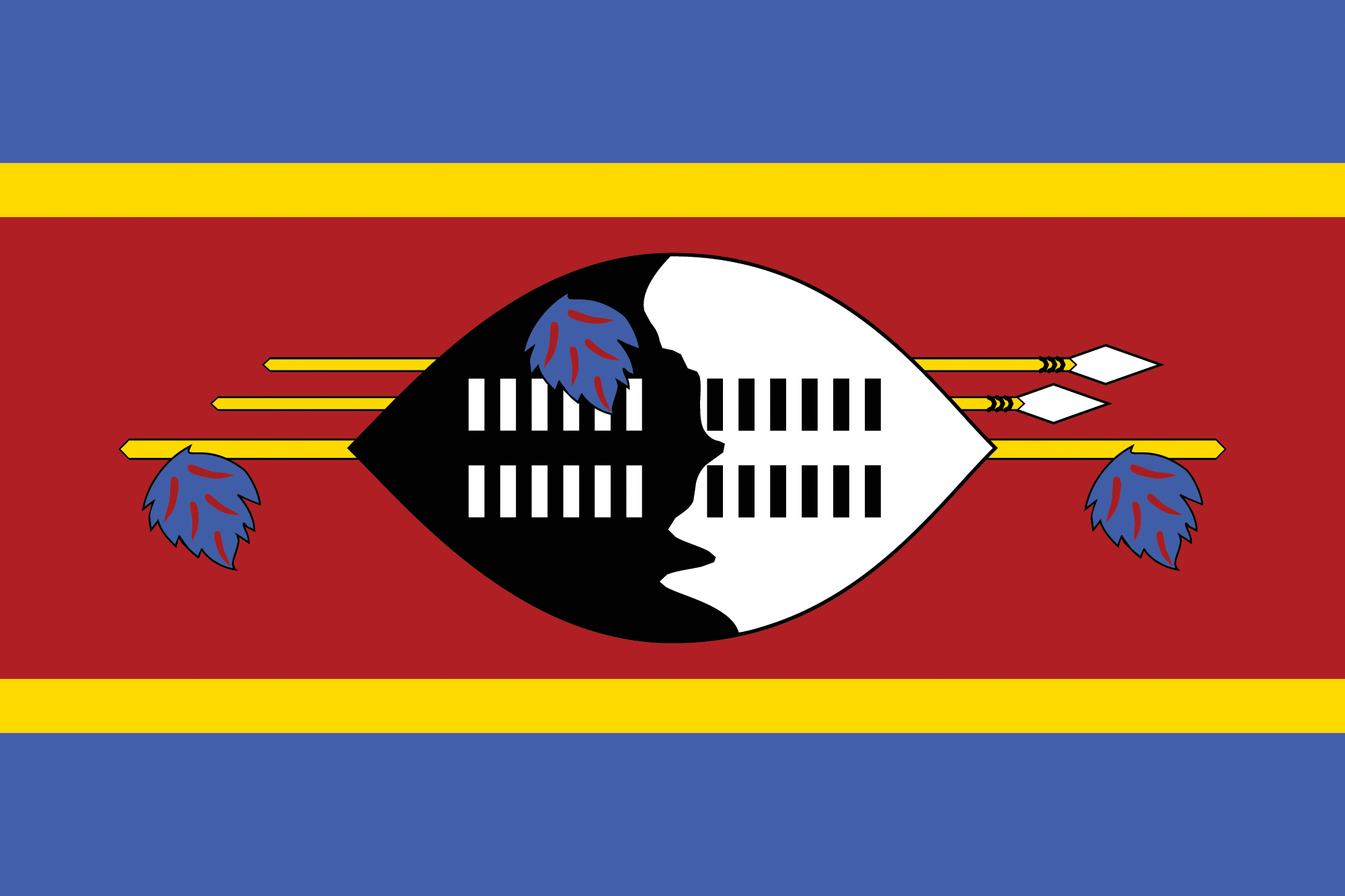Eswatini << `eh`swuh TEE nee >> is a small country in southern Africa. It is bordered by the Republic of South Africa on three sides and by Mozambique on the east. Eswatini has rich mineral deposits, large forests, and good farm and ranch land. However, most of the processing plants and profitable farms are owned by people of European origin. Most people of African origin in Eswatini are peasant farmers.

Eswatini was formerly a British protectorate. It became independent in 1968 as the Kingdom of Swaziland. Mbabane is Eswatini’s administrative capital. Lobamba, a village, is the traditional, or royal, capital, and the legislative capital. Manzini is the country’s main commercial center. The country was renamed the Kingdom of Eswatini in 2018. Its name is also spelled eSwatini.
Government.
Eswatini is a monarchy. The Ngwenyama (king), a hereditary leader, rules the country, with the assistance of a council of ministers and a national legislature. The Ndlovukazi (queen mother, or mother of the king) is in charge of national rituals. If the king’s mother is no longer living, one of the king’s wives may act as Ndlovukazi.

People.
The vast majority of Eswatini’s people belong to the Swazi ethnic group. They speak siSwati, a Bantu language. Small numbers of people belong to other African ethnic groups or are Europeans. Most of Eswatini’s people farm and raise livestock. Some live in towns and work in factories, offices, and shops.


Swazi farmers prize their cattle and respect people with large herds. Traditionally, Swazi do not kill cattle for food, but some are sold for cash or sacrificed at religious ceremonies. When a Swazi man marries, his family gives his wife’s family cattle to legalize her status as his wife.
Swazi men may have more than one wife. The traditional family includes a man, his wives, his unmarried children, and his married sons and their families. Each family lives in a separate homestead. For hundreds of years, the homesteads consisted of circular houses built around a cattle pen. Today, many wealthy Swazi live in Western-style houses. In traditional, rural homesteads with more than one wife, each wife has her own living quarters. She also has a garden plot where she grows beans, corn, gourds, and other crops. The Swazi men and boys tend the family’s cattle.
Traditional Swazi clothing is made of animal skins, leather, or brightly colored cloth. Swazi also wear beautiful beaded ornaments. Today, most Swazi wear clothing similar to that worn by North Americans or Europeans.
Each Swazi man belongs to an age group organized by the Ngwenyama. All the men in a particular group are about the same age. Different age groups have special parts in Swazi ceremonies. Most of Eswatini’s adults can read and write. Most of the population is Christian or Zionist (a blend of Christianity and traditional ancestor worship). Many other people are Muslims.
The Europeans in Eswatini own farms, mines, and forests. Many Eurafricans (people of mixed descent) work for Europeans, and others are farmers, craftworkers, or business people. There are some Asian immigrants who work in small businesses.
Land.
Mountains up to 6,000 feet (1,800 meters) above sea level rise along Eswatini’s western border. Vast pine forests cover much of the land there. Temperatures average 60 °F (16 °C), and from 45 to 75 inches (114 to 191 centimeters) of rain falls each year. Rolling, grassy midlands lie east of the mountains. More people live in this region than in any other part of the country. Temperatures average 66 °F (19 °C), and from 30 to 45 inches (76 to 114 centimeters) of rain falls there each year. Farther east, the land levels off into a low plain covered with bushes and grass. Temperatures average 72 °F (22 °C), and only about 20 inches (51 centimeters) of rain falls per year. The high, narrow Lebombo Mountains rise along the eastern border.
Eswatini is one of the best-watered areas in southern Africa. Four main rivers flow eastward across the country. They are the Ingwavuma, Komati, Umbuluzi, and Great Usutu. The rivers supply the water needed to irrigate crops and to run hydroelectric power plants.
Economy.
Eswatini has a developing economy. The country has a high unemployment rate, and many of its people live in poverty. Foreign aid and remittances (money sent home) from Swazi working abroad are helpful sources of national income.
More than half the country’s land is owned by the Ngwenyama and is called Swazi Nation Land (SNL). Many Swazi graze cattle and grow food for their families on SNL. Since the 1960’s, an increasing number of Swazi have been raising cash crops, especially corn and cotton, on SNL. Europeans own much of the privately owned land in Eswatini. They raise many of the cash crops, including citrus fruits, cotton, pineapples, and sugar cane. They also raise cattle, chickens, goats, and hogs.
Since the 1960’s, a number of small manufacturing firms have developed in Eswatini. Today, manufacturing accounts for much of both the country’s employment and its total economic production. Factories in Eswatini produce clothing, soft drink concentrates, sugar, and textiles.
Rich mineral deposits lie in the mountains. However, mining plays only a small role in Eswatini’s economy. The country mines coal and gold.
Service industries account for much of the country’s total economic production. Hotels, restaurants, and shops are especially helped by the hundreds of thousands of tourists who visit Eswatini from South Africa and other places each year.
Eswatini exports chemicals, clothing, perfumes, and sugar. Leading imports include food, machinery, and transportation equipment. Eswatini’s leading trade partner is South Africa. Eswatini also trades with other African countries, China, and the United States.
Most of Eswatini’s roads are unpaved. Winding footpaths run between most homesteads. A railroad connects Sidvokodvo with the port at Maputo, capital of Mozambique. The government controls the country’s main radio and television stations. Cell phone and internet usage have increased rapidly since the early 2000’s.
History.
According to the legends of the Swazi, their ancestors once lived near what is now Maputo, Mozambique. In the late 1700’s, the Swazi chief Ngwane II led a small band of people over the mountains to what is now southeastern Eswatini. There the Swazi found other African peoples. Ngwane II and the chiefs who ruled after him united several of these peoples with the Swazi.
British traders and Boers (chiefly Dutch farmers from South Africa) first came to what was then known as Swaziland in the 1830’s. In the 1880’s, the settlers discovered gold. Hundreds of prospectors rushed into the region. They asked the Swazi chief and his advisers to sign documents granting them rights to mine minerals and to use land for farming and grazing. The Swazi leaders could not read and did not realize that they were giving up control of the land.
In 1894, the British and Boers agreed that the South African Republic, a Boer state, would govern Swaziland. But in 1902, the Boers lost a war with the British, and the United Kingdom took control of Swaziland. The United Kingdom ruled Swaziland until the mid-1960’s. In 1967, Swaziland gained control over its internal matters. It received full independence on Sept. 6, 1968. On Sept. 24, 1968, Swaziland became a member of the United Nations.
In 1968, the United Kingdom introduced a constitution to Swaziland. The Constitution established Swaziland as a constitutional monarchy, headed by King Sobhuza II. Many Swazi opposed it because they felt it disregarded Swazi interests and traditions. In 1973, King Sobhuza—at the urging of other conservative Swazi leaders—abolished the Constitution and suspended the country’s legislature. The king began to rule the country with the assistance of a council of ministers. A new legislature was established in 1979.
King Sobhuza died in 1982 after a reign of 61 years. In 1983, one of his sons, 15-year-old Prince Makhosetive, was named heir to the throne. In 1986, the prince was installed as king. He took the name King Mswati III. In the 1990’s, popular unrest forced the government to consider political reforms. In 2005, King Mswati approved a new constitution for Swaziland but maintained his hold on power. In 2018, the king renamed the country the Kingdom of Eswatini.
